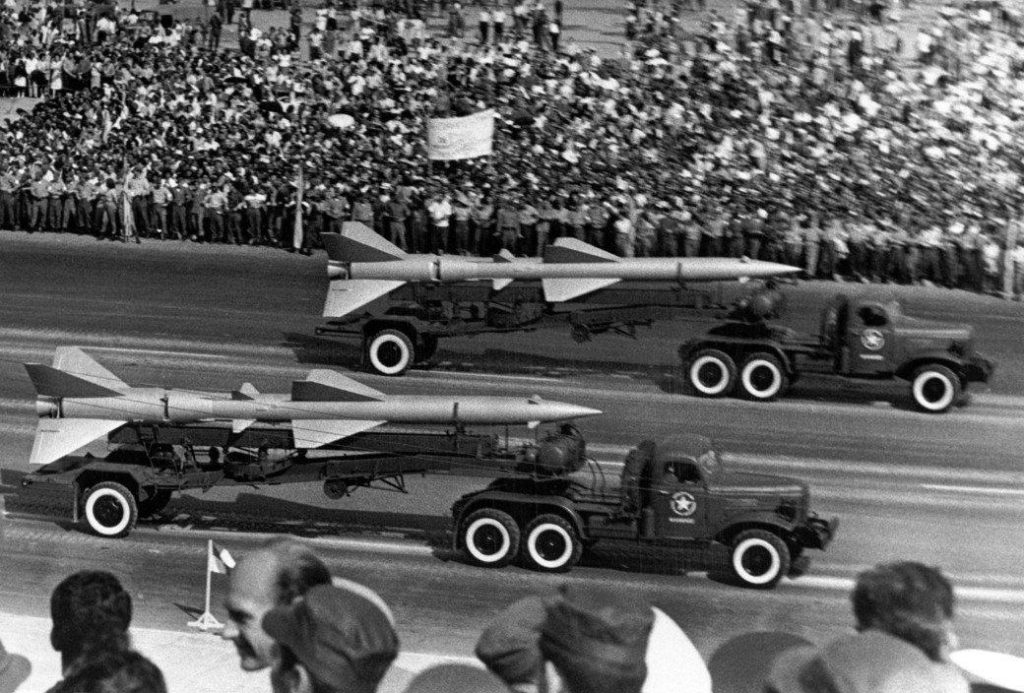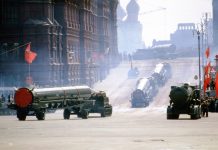
October 16, 1962, John F. Kennedy meets with a small team of advisors known under the name of Ex-Comm. They discuss an appropriate response after a U.S. U-2 spy plane spotted and captured evidence of Soviet missiles and respective launchers being transported to the Cuban countryside. Almost every single advisor in the meeting room urged for a full military response with the evidence before their eyes, but Kennedy was not convinced. He though intensely and tried to understand what was going through the head of the then Soviet premier Nikita Khrushchev. He ultimately came to the conclusion that the Soviets did not want a full scale war, which would also encompass the possibility of nuclear escalation. Kennedy, against the collective opinion of his advisors composed largely of war hungry hotheads, chose to pursue a diplomatic resolution. His suspicion was confirmed not long after. Khrushchev sent a candid letter, revealing his own apprehensions about the spiralling crisis. The letter was not the voice of a belligerent dictator, but that of a leader grappling with the same fears that haunted Kennedy—a catastrophic war neither side could win. Both sides had difficulties proposing any diplomatic solutions. For Khrushchev, backing down would risk projecting weakness, while for Kennedy, engaging in dialogue would risk appearing naive. Both men, however, understood that the stakes transcended personal or national pride. They were safeguarding humanity itself. The crisis was fortunately resolved, when on October 28, 1962, Khrushchev agreed to dismantle the missiles in Cuba in exchange for the U.S. removing its missiles from Turkey.

However, the arguably closest we ever came to World War 3, was on October 27, 1962, when the B-59 Soviet submarine which was submerged near Cuba and armed with nuclear tipped torpedoes was cornered by U.S. Navy ships and subjected to depth charge attacks. The crew, out of communication with Moscow and unaware of the U.S. intent to force the sub to surface, believed they were under attack and that war had already begun.
Captain Valentin Savitsky, convinced they were about to be destroyed, ordered the launch of a nuclear torpedo. However, three senior officers, including Vasili Arkhipov, the second captain, needed to agree on the launch. Arkhipov, remaining calm under extreme pressure, refused to give his consent, convincing the crew that the depth charges were a signal, not an attack. His decision prevented the nuclear torpedo launch, and the submarine surfaced and retreated, avoiding a catastrophic escalation. Arkhipov’s actions are credited with averting a potential nuclear disaster during one of the Cold War’s tensest moments.
We came into a hairs’ length of total nuclear escalation and arguably even total nuclear annihilation. It didn’t help that at the time, the U.S. response to a nuclear attack would have been the unleashing of the full U.S. nuclear arsenal, aimed not only at the Soviet Union, but also Eastern Europe and China. This would have resulted at that time in an estimated death toll of around 700 million people in an instant. This event sparked major changes in history about how nuclear weapons were viewed. It was crystal clear that there needed to be a decisive and collective effort to regulate the use of nuclear weapons, perhaps even complete nuclear disarmament.
Now that we understand just how close nuclear weapons took us to the brink of annihilation, let’s have a look at how they came to be and how their use evolved in history. Just before the second world war, Austrian-Swedish physicist Lise Meitner, working with German chemist Otto Hahn were among the first to successfully achieve nuclear fission (when a neutron slams into a larger atom, forcing it to excite and split into two smaller atoms) of uranium, marking the beginning of the nuclear age. It was quickly realised that this process could also very well be used in a new type of bomb. The U.S. joined the race with the famous Manhattan Project on August 13, 1942 under the supervision of the theoretical physicist and professor of physics at the University of California, J. Robert Oppenheimer. The first successful test, also called “The Trinity Test” was conducted in Alamogordo, New Mexico, 200 miles (ca. 322 km) south of the project site. The test bomb, nicknamed Gadget, contained 13 pounds (ca. 6 kg) of plutonium, detonated with an implosion-method.
At 5:29 a.m. on July 16, 1945, the most destructive man-made weapon in human history has seen the first light of day.
A massive flash, created by the explosion of roughly 21 kilotons of TNT, blinded observers standing 10’000 yards (ca. 9.1 km) away. Upon seeing the blast and destructive power of his creation, Oppenheimer uttered, “Now I am become Death, the destroyer of worlds.” The successful test subsequently led to the dropping of two nuclear bombs over Hiroshima and Nagasaki, after the refusal of an unconditional surrender by the Japanese government, heralding the end of the war. The damage caused by the bombs in Hiroshima and Nagasaki were devastating, with casualty numbers reaching as high as 70’000 and 40’000 respectively, without counting the after-effects of radioactive poisoning. In a sense, the Manhattan Project and the use of atomic bombs on Japan, to end the war, forced humanity into a new atomic age that would forever alter the nature of global conflicts and warfare.
Just four years after the end of WW2, the first soviet nuclear test was conducted on August 29, 1949 on a test range in Kazakhstan. This had some major implications for the international power balance at the time. It came as quite the shock to the United States, who believed that the soviets were at least three years behind regarding nuclear technologies. This opted the U.S. to adapt a more aggressive nuclear policy, funnelling more money and resources into the research and production of nuclear technology. I believe that a more diplomatic approach would have been wiser and more efficient in preventing the security dilemma in which the U.S. and the Soviet Union found themselves in. Unfortunately, as history shows us, more often than not, fear, uncertainty, and distrust have trumped human reason again and again. Leaders have seen themselves forced to prioritize the security and power of their State above all else—quite the pessimistic and realist world-view. This fear and distrust between the U.S. and the Soviet Union ultimately lead to an uncontrolled arms race for nuclear supremacy. In 1945 there were 2 nuclear weapons in existence, 304 in 1950, 2’636 in 1955, 20’285 in 1960, reaching its peak in 1986 with an astonishing amount, totalling about 69’368 nuclear warheads in existence (Norris & Kristensen, 2010). They were shared between the U.S., the Soviet Union, the United Kingdom, France, China, Israel, later joined by India and Pakistan. Israel, India, and Pakistan are not part of the Non-Proliferation Treaty or NPT. Israel in particular has never publicly admitted its possession of nuclear weapons until today.
There was though a glimpse of hope, amidst all the distrust and chaos by which the Cold War period was marked. On June 10, 1963, John F. Kennedy held arguably one of the finest and most moving speeches given by a U.S. president. In this speech, Kennedy did not depict the Soviets as the absolute evil, but as fellow human beings. While their philosophies may differ, Kennedy urged to focus on similarities instead of differences and emphasised on the need for mutual respect and cooperation in the face of ongoing difficulties.
“No government or social system is so evil that its people must be considered as lacking in virtue. As Americans, we find communism profoundly repugnant as a negation of personal freedom and dignity. But we can still hail the Russian people for their many achievements – in science and space, in economic and industrial growth, in culture and in acts of courage.”
President John F. Kennedy
Washington, D.C.
June 10, 1963
Apparently Khrushchev was so moved by that speech, that he allowed not only the broadcast of the full speech, but also ordered its full uncensored translation and reprint in the controlled soviet press (Pravda, Izvestija) which at the time was unprecedented. According to some, this was a pivotal moment which contributed massively to diplomatic talks and the signing of the Limited Nuclear Test Ban Treaty just four months later. Unfortunately, after the assassination of JFK, the relations worsened significantly, marking a huge setback in U.S. Soviet relations.
Let’s take a step back and analyse how nuclear deterrence played its role in the Cold War and why it spiralled out of control. The policies and decisions taken at that time were undoubtedly a reflection of the previous two world wars, which in some ways had contradictory lessons. On one hand, you had the first world war, which seemed to argue against arms races and self-fulfilling prophecies. On the other hand, you had the second world war which argued strongly against the temptation of appeasement, looking back at what happened with the agreements made in Munich between Hitler and Chamberlain and the ultimate betrayal by Hitler. This sentiment and mentality not to trust the other side under any condition and circumstance was strongly felt and supported by both sides, especially by the Soviet Union, who had just lost around 20 million people during the war. Any attempt to build trust with the other side would be met with extraordinary harsh attacks by hardliners, who argued that the other side could never be trusted to abide by any agreements. So one of the problems which prevented any progress towards much-needed agreements on nuclear disarmament, and ultimately peace, was the fundamental lack of trust between the U.S. and the Soviet Union. This concern was only amplified by the fact that both sides had access to nuclear weapons. The next issue can be summed up perfectly by The Security Dilemma. In simple terms, the security dilemma argues that a defensive action taken by one party will often be viewed as an offensive action by the other.
So if the U.S. increases its nuclear arsenal to deter a potential Soviet conventional invasion of Europe, the Soviet Union may interpret this as preparation for a nuclear first strike rather than a defensive measure. In response, when the Soviet Union expands its own nuclear capabilities to match those of the U.S., American hardliners might view this move as an attempt to undermine U.S. nuclear deterrence, potentially in order to enable a conventional military offensive. This vicious cycle of distrust only accelerated the arms race, forcing both sides to expand their nuclear arsenals to frightening levels in just a couple of years. Each side feared to be on the receiving end of a pre-emptive strike. The U.S. were also considering sharing their nuclear stockpile with other states and potentially industrialising and rearming West Germany. This was completely unacceptable in the eyes of the Soviet Union after what they just went through in the second world war. Apparently having nuclear weapons pointed at you from your front yard, held by a country which cost you more than 20 million casualties, doesn’t make you feel very safe. This stalemate between both the U.S. and the Soviet Union would continue over the years until the fall of the Berlin Wall, and just one year later, the dissolution of the Soviet Union.













